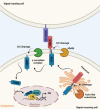Notch signaling in female cancers: a multifaceted node to overcome drug resistance
- PMID: 35582386
- PMCID: PMC8992449
- DOI: 10.20517/cdr.2021.53
Notch signaling in female cancers: a multifaceted node to overcome drug resistance
Abstract
Drug resistance is one of the main challenges in cancer therapy, including in the treatment of female-specific malignancies, which account for more than 60% of cancer cases among women. Therefore, elucidating the underlying molecular mechanisms is an urgent need in gynecological cancers to foster novel therapeutic approaches. Notably, Notch signaling, including either receptors or ligands, has emerged as a promising candidate given its multifaceted role in almost all of the hallmarks of cancer. Concerning the connection between Notch pathway and drug resistance in the afore-mentioned tumor contexts, several studies focused on the Notch-dependent regulation of the cancer stem cell (CSC) subpopulation or the induction of the epithelial-to-mesenchymal transition (EMT), both features implicated in either intrinsic or acquired resistance. Indeed, the present review provides an up-to-date overview of the published results on Notch signaling and EMT- or CSC-driven drug resistance. Moreover, other drug resistance-related mechanisms are examined such as the involvement of the Notch pathway in drug efflux and tumor microenvironment. Collectively, there is a long way to go before every facet will be fully understood; nevertheless, some small pieces are falling neatly into place. Overall, the main aim of this review is to provide strong evidence in support of Notch signaling inhibition as an effective strategy to evade or reverse resistance in female-specific cancers.
Keywords: Notch signaling; cancer stem cells; drug efflux; drug resistance; epithelial-to-mesenchymal transition; female-specific cancers; tumor microenvironment.
© The Author(s) 2021.
Conflict of interest statement
All authors declared that there are no conflicts of interest.
Figures


References
Publication types
LinkOut - more resources
Full Text Sources
